#harvest town ortiz
Text

The children are on their way to help Teegan with her farm! And probably eat the fruit and take some of her products.
Taking a short break between the HPHM!Cardverse AU. I don’t want to end up going through with treating my interest as a chore again. I will let you know though that the next character for the AU will be the King of Clubs. And the traits for Clubs are; Mind, Nature, Knowledge and Communication. Hope you can guess who the king will be ☺️
🚫No Reposting🚫
#ariparri#jerry allen#Justin Ortiz#glen cruz#peach gray#harvest town#harvest town fanart#harvest town game#farming simulator#harvest#fanart#game fanart
73 notes
·
View notes
Text

Fuck everything, I'm adopting him. He's my kid now. I'll protect him with my life.
#he deserves better#Harvest Town Justin#Justin Ortiz#Harvest town justin ortiz#harvest town#I wish we could adopt him 😔
3 notes
·
View notes
Text
Foxy: Pink, Purple, Blue
Jim, clearly drunk: Watermelon!
Foxy: … no
#harvest town#foxy harvest town#jim ortiz#Jim Ortiz Harvest Town#harvest town incorrect quotes#incorrect harvest town quotes#incorrect quotes
29 notes
·
View notes
Text
Jim Oritz & Justin Oritz | Harvest Town Easter Eggs
In my previous Harvest Town post, I touch on where you can find Fisher the Merman. In this post, I’ll touch on the Oritz residence.
Backstory on the Oritz family
Jim Oritz is the father of Justin Oritz. Jim is often drunk and upset about his wife abandoning them. At his drunken state, he touches on bits and pieces of his past like how his wife wants something more than this town and went to the city. He also used to travel around before having Justin, sharing his adventures with Foxy. One could infer that Jim was a travelling artist from his lost painting in one of the quests.
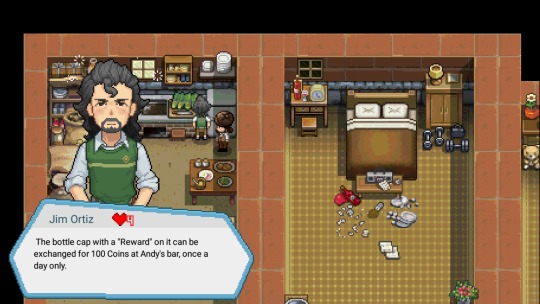
Bottle Cap Adventures - Special Event Trigger
To get the special bottle cap, you would have to first trigger the special event at the Oritz residence.
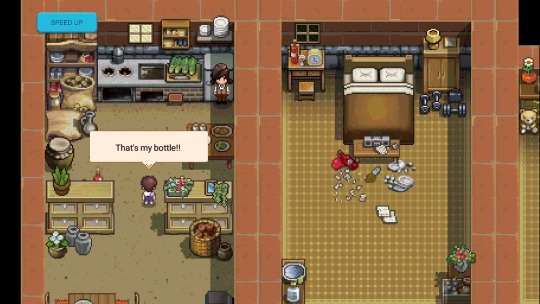
To trigger the event, you have to go to the Oritz residence and click on their refrigerator. That will trigger a short cut scene where Justin runs up to you angrily saying, “That’s my bottle!”
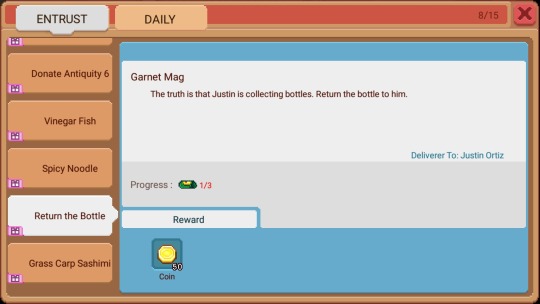
You will need to return the bottles to him before he will tell you why he is collecting these empty glass bottles. This part of the story will be linked to Peach, the girl that Justin have a crush on. He is collecting the bottles for her.

Moving on to Peach, you’ll give the bottles to her. She’ll bring it to the sea and throw the bottle with the note in it. Apparently, she was trying to reach her parents through this method since they are working in the city.
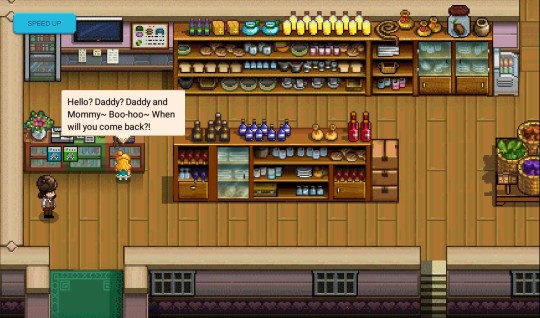
Finally, you’ll bring her to the store where she uses the phone to call her parents.
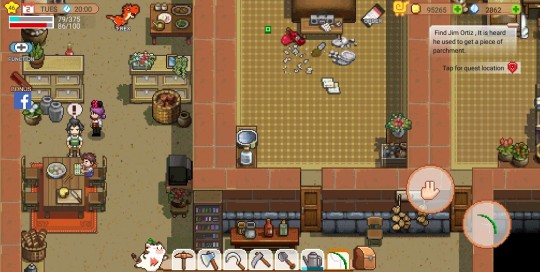
Jim Oritz Tries to be a Good Father
Despite Jim’s alcoholic ways, Jim tries to be a good father to Justin. If you head to the Oritz residence at different times of the day, you can see Jim standing over Justin, guiding him or supervising him with his homework.
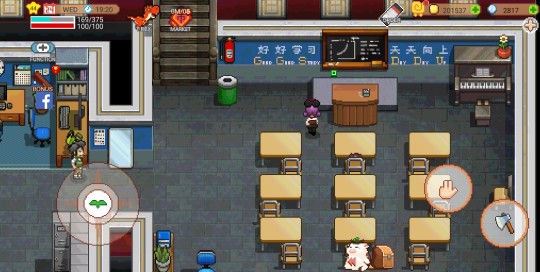
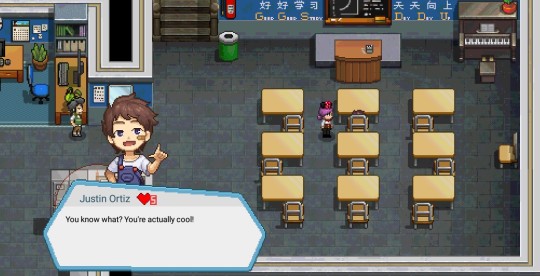
Even at school when everyone have left, you can see Justin being the only person in class while his father patiently waits for him at the side till it is way past your bedtime.

Another easter egg I found was Justin hiding in between the bookshelves trying to write a word that he was not familiar with. Justin was a hardworking boy despite of his circumstances.

Jim Oritz misses his wife
Sometimes, you’ll see Jim standing by the lone tree at the factory, drinking. There used to be a bus service that goes through the factory. I think he was reminiscing the days where he let his wife board the bus.

Justin Ortiz misses his Mother
At another bus stop right above the horse range, you can see Justin Ortiz at this location every weekend waiting for the bus service that no longer function.
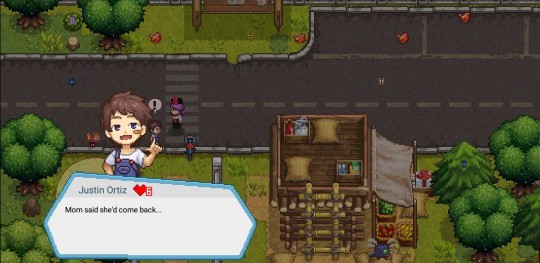
This is a sad situation for you get this dialogue, “Mom said she’d come back..” that shows how much Justin misses his mother.
Who is to blame?
Jim for not being enough for his wife? Jim’s wife for wanting more with her life so she left? Ultimately, this is a story of a father and son trying their best to survive in the small town in their own ways.
Check out my other Harvest Town content:
Fisher’s location
Jim & Justin Oritz Easter Egg
Harvest Town Easter Egg
What will happen if you wake the residences up in Harvest Town?
Mythical Creatures in Harvest Town
If you prefer videos, watch my Harvest Town gameplays here:
Beach Party, Dance Festival + Hotpot Party
Hunting for Christmas Gifts at the Christmas Event
Harvest Town Full Gameplay (Whale Island)
Is Harvest Town merely a Chinese Stardew Valley?
#harvest town#justin oritz#jim oritz#ortiz#harvest town easter egg#harvest town tip#harvest town ortiz#fandom
47 notes
·
View notes
Text
Falling palay prices worry Luzon farmers
navigation
Falling palay prices worry Luzon farmers
4 weeks ago
GRAINS GENTLY FALL A farmworker spreads palay (unhusked rice) for drying along the shoulder of the Pangasinan-Tarlac highway in Aguilar town, Pangasinan province. Farmers in rice-producing provinces in northern and central Luzon have been complaining of falling grain prices. —WILLIE LOMIBAO
CITY OF SAN FERNANDO, Pampanga, Philippines — Toto Mandap, a rice farmer in Apalit town, Pampanga, has to mill his harvest and sell it for P1,900 per cavan to avoid traders who buy palay (unhusked rice) at between P8 and P10 a kilogram.
Mandap tills a 1.5-hectare of well-irrigated farm at Barangay Cansinala in Apalit, which is beside the Pampanga River.
While he harvests 100 cavans, he said the low buying price of palay put him on the losing end so he had to sell milled rice to his friends for P38 per kg.
Farmers in the provinces of Nueva Ecija, Pangasinan, Isabela and Ilocos Norte said the average farm-gate price of palay fell to as low as P7 per kg.
To cope with the rising production cost, Lyndon Madrid, a farmer from Ilocos Norte said he would rather mill his palay and sell its byproducts, such as rice bran at higher prices.
Records from the Philippine Statistics Authority (PSA) also showed a downtrend in palay prices across the country this month.
In an advisory issued on Wednesday, the PSA said the average farm-gate price of palay dropped to P17.62 per kg from P17.72 in the previous week.
New law blamed
Ignacio Ortiz, chair of Alyansa ng Magbubukid sa Gitnang Luzon-Nueva Ecija, said the new low price was a result of the rice tariffication law (Republic Act No. 11203). The law has opened the country to importation of cheap rice that has been flooding the local market.
“Rice liberalization has caused so much damage to farmers,” Ortiz said in a statement.
On Wednesday, women farmers’ group Amihan and rice watch group Bantay Bigas called for the repeal of RA 11203 during a public hearing led by the Senate committee on agriculture and food.
The two groups said rice retail prices remained unaffordable to poor consumers since the National Food Authority (NFA) rice was almost unavailable to consumers.
This forced consumers to buy commercial rice at P36 to P50 per kg, the groups said.
Farmers in Kalinga province, considered the rice granary of the Cordillera, are also reeling from the effects of rice tariffication.
The farm-gate price of palay in Kalinga dropped to P10 per kg, the farmers said, as they sought seed subsidy on hybrid rice varieties. They said hybrid rice varieties produced higher yield and were more resistant to diseases and insects.
Incentives
At the Senate hearing, Sen. Cynthia Villar, committee chair, proposed to remove the incentives given by the NFA to farmers when buying palay to allow the agency to purchase more of the crop as prices continued to fall.
She also said the NFA’s buying price for palay should be reverted back to P17 per kg from P20.70 to help more farmers.
The move will give immediate relief to rice producers as the average farm-gate price of palay declined anew to P17.62 per kg as of the second week of August. Compared to the year-ago rate of P22.28 per kg, this was lower by 20 percent.
In some provinces, palay prices have decreased further. In Cavite, palay was sold at an average of P12 per kg. In Davao and Surigao del Sur, prices were at an average of P14.99 and P14.35 per kg, respectively.
While the NFA has been surpassing its procurement targets as of late, the onset of the harvest season in September is expected to drown the market with both imported and local rice, which will add to farmers’ woes.
The NFA offers a buying price of P17 per kg, but this can increase to P20.40 and P20.70 per kg for individual farmers and farmer cooperatives, respectively, when incentives for drying and delivery are included.
The agency’s procurement activities are an important safety net for rice farmers as some traders have already adjusted their buying price to as low as P13 per kg following the entry of more affordable imported rice in the market.
Given funding restrictions, however, the NFA would not be able to cover all farmers if it continues with its incentive program.
—Reports from Tonette Orejas, Armand Galang, Leilanie Adriano, Yolanda Sotelo, Villamor Visaya Jr., Karlston Lapniten and Karl Ocampo
READ NEXT
1 note
·
View note
Text
The Place of White Shells by the Water
Santa Fe (Ogha Po'oge - The Place of White Shells by the Water) is a part of the ancestral homeland of the people of the Pueblo of Tesuque. Ancestors of the Pueblo settled there between 600 AD - 1425 AD (although there are even older archeological sites dating to 3000 BC) (1).
The Spanish conquest of northern New Mexico began in the 1500s. In the 1540s, the second Spanish expedition into New Mexico began, which was led by de Coronado. Mr. Alfonso Ortiz, a Tewa scholar, describes the expedition as “a rampage of death, deceit, and destruction through Pueblo country” (2). Between the 1580s and 1590s, there were three more attempts to colonize New Mexico by the Spanish, resulting in more destruction and attacks on Pueblo country. In 1680, the Pueblo Revolt took place: “the result of almost three generations of Spanish colonial rule and oppression.”
For 82 years leading up to the revolt, the encomienda system was in place, in which each Pueblo household was taxed (half of their harvest, textiles, pottery, etc), with the profits going to the Spanish government. The repartimiento system enabled the Spanish to profit from Pueblo physical labor to build missions, government buildings, and to serve in Spanish households. This was all happening at the same time as smallpox, drought, and famine - significant stresses that resulted in the decimation of some of the Pueblos.
The origins of the revolt began when the Spanish governor arrested leaders of Native religious practices (Medicine Men). They were put on trial in Santa Fe, convicted, and either hanged or publicly whipped and sentenced to slavery. Pueblo leaders and warriors responded by marching on Santa Fe, demanding the release of those who were imprisoned. One leader traveled to the Taos Pueblo upon his release, and planned the revolt, leading to a battle over Santa Fe resulting in Pueblo warriors surrounding Santa Fe and cutting off food and water supply to the town. This resulted ultimately in 12 years of Pueblo ownership of Santa Fe. The Revolt “[should] be understood first and foremost as a religious restoration” (Alfonso Ortiz).
For further reading, I would highly recommend “White Shell Water Place: Native American Reflections on the Santa Fe 400th Commemoration” (compiled by F. Richard Sanchez).
Sources:
1. White Shell Water Place: Native American Reflections on the Santa Fe 400th Commemoration, p. 22
2. White Shell Water Place, p. 23
History summarization from White Shell Water Place.
0 notes
Text
‘Necessity’: Those in US illegally push for license to drive
ALBION, N.Y. — Dairy farm worker Luis Jimenez gambles every time he drives without a license. Even a minor traffic stop could alert immigration agents that he is in the country illegally and lead to deportation.
But in the wide open spaces of upstate New York’s farm country, supermarkets and job sites are often too far away for walking, there’s not always somebody around to give you a ride, and catching a city bus or subway just isn’t an option.
“Necessity forces us to take a risk,” Jimenez said in Spanish as he drove home recently. “We have to work, we have to buy food. Sometimes we get sick and workers like me can’t drive to a hospital, can’t buy medicine. But I feel I need to take the risk so that my kids and my family can have a better life.”
In New York and elsewhere, the idea of extending new privileges to those without legal immigration status has been resisted. But a renewed push across the country to allow them to get driver’s licenses resonates strongly among those who make their living in the rural crop fields, dairy farms and fruit orchards where the need for everyday transportation can be the greatest.
Apple orchard worker Eladio Beltran, who is facing deportation after a traffic stop, says licenses also could alleviate the constant fear workers like him live under.
“We don’t feel safe,” Beltran said. “If you are in a vehicle and you see a cop, you know any time he can turn his lights on. And you end up arrested; you end up in Mexico.”
Immigrants and their advocates have already gotten access to such licenses in a dozen states including California, Colorado and Illinois, some of them accepting state tax returns as identification. They are now targeting roughly a half-dozen states where they see a friendlier political landscape this year. That includes Wisconsin and New Jersey, where Democratic governors succeeded Republicans, and New York, where Democrats now are in total control of the Legislature.
“Now there’s a new urgency to really try to get this done, and there is new political opportunity,” said Christine Neumann-Ortiz, executive director of Voces de la Frontera, an immigrant advocacy group based in Milwaukee.
The laws could give state-level protection to immigrants who fear more aggressive enforcement by federal immigration agents under the Trump administration. Bolstering those fears is the impending departure, announced over the weekend, of Homeland Security Secretary Kirstjen Nielsen , who had been viewed as resistant to some of the harshest immigration measures supported by Trump and his aides.
Advocates say police would still be able to view drivers’ past infractions, but they say immigrants producing a valid license will be less likely to face further questions and contact with federal agents.
In New York, farmworkers make up only about 10,000 of the estimated 265,000 immigrants without legal documents expected to get driver’s licenses, according to the Fiscal Policy Institute. But they might get the most use out of licenses.
Ismael Castellanos is driven a mile daily from the home he shares with four other immigrant workers to the dairy farm where he cares for calves. Trips for a carton of milk or a dozen eggs can be more problematic, and pricey. The nearest grocery store is 8 miles away, and he pays people with cars between $30 and $40 per trip.
“You have to call the person and ask which afternoon he has off so he can drive you, so you do grocery shopping that day,” Castellanos said in Spanish.
Castellanos, Beltran and Jimenez spoke to The Associated Press on the condition that names of the farms where they work are not disclosed. They are part of a group called Alianza Agricola, which is lobbying for the license law in New York.
It’s unclear whether attitudes have changed much in New York since 2007, when then-Gov. Eliot Spitzer attempted to adopt such a license measure but was forced to back off amid withering political opposition. A poll from Siena College last month found New York residents still opposing the idea by almost 2 to 1.
State Sen. Daphne Jordan argues the law would lead to voter fraud, bank fraud and identity theft. The Albany-area Republican said an online petition she started found similarly strong opposition.
“If they want to stay here, then they should become citizens,” Jordan said. “We have a system in our country. And it’s there for a reason. And so just follow the system and be here legally, and that’s the answer to all of it.”
Advocates say the bill will help the state, as well as immigrants, thanks in part to additional revenue from car registrations and sales taxes. As immigrants register cars, they will buy insurance. They also point to a study that found states with license laws average lower traffic fatality rates, presumably because the immigrant drivers have passed state-administered driving exams.
“Not only does it protect the undocumented immigrant farmer who is harvesting our products, our agricultural products, but it protects society as a whole,” said sponsoring state Sen. Luis Sepulveda, a Bronx Democrat.
Beltran said he faced possible deportation after being stopped for speeding in 2014 as he was driving to buy bronchitis medicine for one of his daughters. The local police notified Immigration and Customs Enforcement, which said it administratively halted his immigration proceedings in 2016 on humanitarian grounds.
Then in 2017, local police stopped him for driving the wrong way down a one-way street, according to federal officials. Beltran said he was driving to a gas station in an unfamiliar town. Police called Customs and Border Patrol officers, who arrested Beltran because of his reentry after a 2008 deportation. His immigration case was reopened, leading to a hearing in Buffalo next month.
The 32-year-old father of four continues to work, but the hearing is on his mind. On a recent cool spring morning, he trimmed a neat row of apple trees, knowing he might not see them bear fruit.
“I am working today but days go by fast. Will I go back to my family after entering immigration court?” he said. “If I get deported, when will I see them again?”
——
Associated Press writer Deepti Hajela in New York contributed to this report.
from Financial Post http://bit.ly/2VuFidj
via IFTTT Blogger Mortgage
Tumblr Mortgage
Evernote Mortgage
Wordpress Mortgage
href="https://www.diigo.com/user/gelsi11">Diigo Mortgage
0 notes
Text

The only Halloween theme art I’ve done throughout the entire month (´°̥̥̥̥̥̥̥̥ω°̥̥̥̥̥̥̥̥`) I really wanted to do more, but I never had the chance to do so.
Originally I wanted to draw the kids eating their candy at Teegan’s place, but I wasn’t up for it. So I went with them looking at fireflies instead!
Also wanted an excuse to draw Peach as Princess Peach (๑˃̵ᴗ˂̵)
❌ NO REPOSTING ❌
#ariparri#peach gray#glen cruz#jerry allen#Justin ortiz#harvest town#harvest town fanart#happy halloween#halloween art
25 notes
·
View notes
Text
Sapa Vietnam :: One of the Most Beautiful Places on Earth
Tweet
Happy Friday everyone from one of the most beautiful places on Earth! A huge claim, I know. But Sapa, a mountainous town in northwestern Vietnam, is truly breathtaking. We booked only one night in Sapa, but decided to extend our stay for another night after witnessing its beauty. I honestly wasn’t planning to do a photo story in Sapa (mainly because we didn’t know what to expect), but this location is so beautiful that we couldn’t help but share. The colors of blue, green, and aqua are more spectacular in real life. Since we’re at the beginning of planting season, the rice fields are still brown. Once harvesting season starts (around September), the rice fields turn into vibrant hues of green and gold.
Every morning starts with a bowl of pho and I couldn’t be happier! Breakfast surrounded by mountains and this incredible view.
Johanna Ortiz ruffled bikini top | Johanna Ortiz high-rise bikini bottom
After posting this image on my IG @wendyslookbook, a lot of people asked about the location. We stayed at the Topas Ecolodge in Sapa. Just a note, Sapa is about 5 hours from Hanoi. The only way to get to Sapa is by train, bus, or car. Additionally, Topas Ecolodge is situated high up in the mountains and is about 50 minutes from Sapa town (which is quite charming!). Most people who stay at this lodge take a day trip to Sapa town. If you’re thinking/considering/planning a trip to Vietnam, I highly recommend Sapa! Fly into Hanoi (we flew from Saigon to Hanoi for $25 one way/per person via Viet Jet) and make your way to Sapa.
I hope you enjoy the location, photography, and styling! Have a great weekend and thank you so much for reading!
:: Outfit ::
S W I M :: Johanna Ortiz ruffled bikini top | Johanna Ortiz high-rise bikini bottom
D R E S S E S :: Yumi Kim white lace maxi dress | Kasia Kulenty green braided dress
:: Location ::
Topas Ecolodge in Sapa | Lao Cai Province, Vietnam
The post Sapa Vietnam :: One of the Most Beautiful Places on Earth appeared first on Wendy's Lookbook.
from Wendy's Lookbookhttp://www.wendyslookbook.com/2018/06/sapa-vietnam-one-of-the-most-beautiful-places-on-earth/
0 notes
Text
Fay: Pastries are the gateway to the soul!
Jim Ortiz: I think my pastry is burnt
14 notes
·
View notes
Text
What will happen if you wake the residences up in Harvest Town?
Have you ever wonder how the residence will react when you wake them up? I did! Thus, I did a stalkish experiment.
Waking up Before the Residence
Since the protagonist wakes up at 6am, it gives us an hour before they are walking around the village. That means I can only go to a few houses at a day. This experiment took a while to compile but here’s the list.
Do note, this experiment took so long that Harvest Town graphics have now changed so things will look a little different.
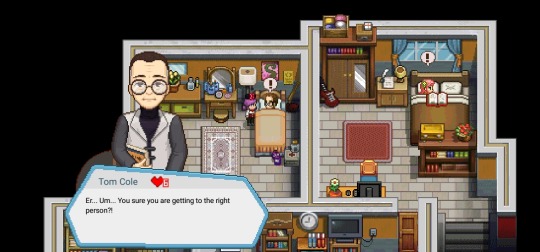
Tom Cole
Er... Um.. You sure you are getting to the right person?!
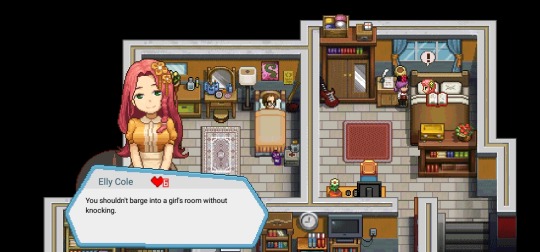
Elly Cole
You shouldn’t barge into a girl’s room without knocking
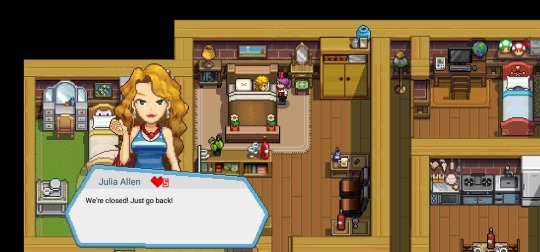
Julia Allen
We’re closed! Just go back!

Elaine Terry
Just five more minutes...

Elaine Terry
Bedtime, bedtime!
When going to sleep

Adam Trump
Er...Um.. You sure you are getting to the right person?!

Lulu Lopez
I have a very tight schedule not like you.
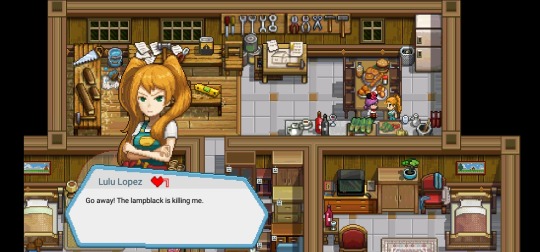
Lulu Lopez
Go away! The lampblack is killing me.
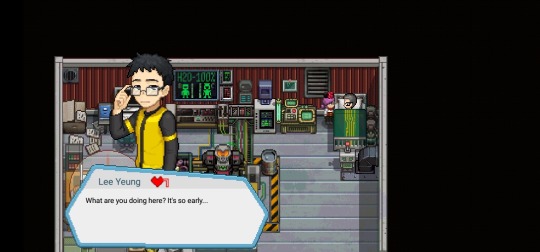
Lee Yeung
What are you doing here? It’s so early...
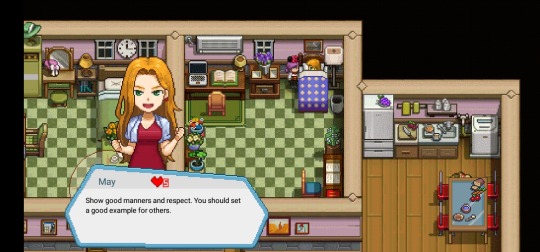
May
Show good manners and respect. You should set a good example for others.

Mary Morris
Er...Um.. You sure you are getting to the right person?!
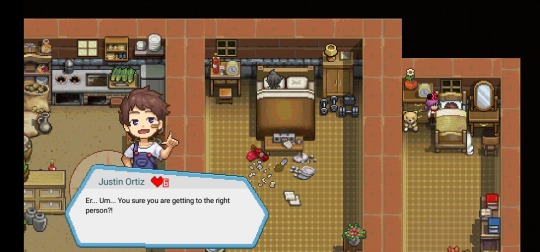
Justin Ortiz
Er...Um.. You sure you are getting to the right person?!
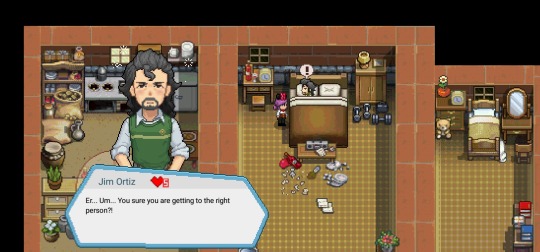
Jim Ortiz
Er...Um.. You sure you are getting to the right person?!
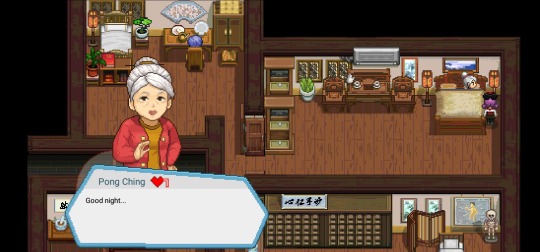
Pong Ching
Good night...
The other residents homes are not accessible in the day so this is my results. As mentioned, Harvest Town have updated its graphics and even how the character reacts to you is different. I’ll be adding more Harvest Town lists so do Follow me!
If you like this list of Easter Eggs, check out my other Harvest Town posts:
Fisher’s location
Jim & Justin Oritz Easter Egg
Harvest Town Easter Egg
What will happen if you wake the residences up in Harvest Town?
Mythical Creatures in Harvest Town
If you prefer videos, watch my Harvest Town gameplays here:
Beach Party, Dance Festival + Hotpot Party
Hunting for Christmas Gifts at the Christmas Event
Harvest Town Full Gameplay (Whale Island)
Is Harvest Town merely a Chinese Stardew Valley?
63 notes
·
View notes
Text
A light amid the darkness, a Puerto Rico church stands up as its community struggles
By Arelis R. Hernández, Washington Post, October 7, 2017
UTUADO, PUERTO RICO--Our Lady of Monte Carmelo Catholic Church tried to hold Mass right after Hurricane Maria passed, but a landslide had knocked out the east wall and filled the tiny sanctuary with thick mud.
The lakeside village of Caonillas had been savaged. The hillsides appeared as if bleeding, scarred by the streaks of dislodged earth and frond-less palm trees. Maria’s winds spirited away zinc and tin roofs. Her deluge sent blood-orange topsoil into homes, onto cars and across roads.
“It was hellish,” said Midge Battistini, a teacher who lost her home near the banks of Lake Caonillas. She said the winds changed direction, creating a funnel effect that sucked up every green thing around.
Tucked into the sparsely populated central mountainsides, the village had been cut off from the rest of the world. No services. No contact. The people of Caonillas had weathered storms before. Hurricane Hugo had been through here. So had Georges. But Maria showed no mercy. There was nothing holy about her.
Carmen Ortiz and her family live nearest to Our Lady of Monte Carmelo, and they worked for a week to dig it out from the mud and clean the pews. On the first Mass after the Sept. 20 storm, the church opened and the Ortiz family--the four of them--were the only ones who could make it. Ortiz sought solace in Father Rafael Rodriguez, sharing her worries, her fears and what her family experienced trapped inside their home as Maria lashed outside.
The church “is the only light I’ve seen in the midst of all this darkness,” she said.
At that first Mass, they prayed that more people would come.
More than two weeks after Hurricane Maria tore a devastating path through Puerto Rico, communities such as this one are still isolated and struggling to meet basic human needs. They are frustrated at what they see as the lack of local and federal attention to their plight. In Caonillas, the effort to re-energize the church has given people a special kind of faith--a special kind of mission--while the world around them remains unsettled and unnerving.
Local officials estimate that nearly every state road in Coanillas and greater Utuado were impassable or collapsed after the hurricane. No homes were left completely untouched in this region of the Central mountain range once ruled by the indigenous caciques, or Taino chiefs, who dominated the high altitude interior until the 15th century, when Christopher Columbus arrived.
“There were roads I didn’t recognize and homes that I was used to seeing that were gone,” said Idhem Heredia, the parish secretary. “There were other homes that I hadn’t seen before because there was so much vegetation. Now they are clear to see.”
Heredia said the region simply wasn’t prepared for what Maria wrought.
When it became obvious that help wasn’t quickly on its way, local residents began fending for themselves as they assessed the ruin around them.
Hector Quiles got busy, using a bulldozer to clear the mud and dead trees from mountain roadways. The coffee grower said Maria wiped out his entire harvest.
Quiles, 40, had coffee, plantains and fruits and vegetables, but he estimated that “about 5 percent is left over, and that is for my family’s consumption.”
Another grower, Angel Gonzalez, vice president of Cafe Don Alonso, had similar laments: “There’s no coffee to process.”
As shock turned to despair, parishioners focused on Our Lady of Monte Carmelo. Roads began to clear and the church started to return to some semblance of its former self. Ortiz’s extended family arrived for a midweek mass, increasing the number of worshipers from four to eight.
Still, they believed, more would come. The parish posted a yellow sign on the front gate: “There will be Mass on Sunday at 11 a.m.”
That Sunday was Oct. 1--11 days after Maria made landfall--and the parishioners began setting up. Plastic chairs were placed at the rear of the church instead of at the altar, away from where the mud had invaded the room. The sound of a tambourine and guitar strokes emanated from the darkened interior, where Ortiz and her daughter were practicing choruses for the service. A painting of La Virgen de la Divina Providencia, the patroness of Puerto Rico, watched over the elements for the Eucharist with the island’s flag--red and white stripes with a blue triangle emblazoned with a white star--draped behind her.
Then the people started arriving.
Jose Maldonado Jimenez, 71, sat outside waiting for the service with about a dozen others; they milled about and shared their stories and traded hugs and kisses. Children chased after a skinny black mutt in the church courtyard, and men with sun-kissed faces wanted to know what President Trump had said about the Puerto Rican recovery that had people so upset down in the town at the base of the mountain.
“This has been out of this world. No one has come around here” with food and water, Maldonado Jimenez said. “Here in the country, we can eat from the earth and we can draw water from the mountain for a while. We can live without electricity, but we planned for seven days, not two weeks. But we will figure out a way.”
The parish bell began to toll, signaling to the homes on the mountainside and the valley below that mass would soon commence.
Father Rodriguez put on his robes in a back room next to Quile’s eldest son, who struggled to find the slot for his head in his altar boy cassock. The doors all were open.
The bell rang again, and 20 people took their seats. It was steamy, uncomfortable. Whispered conversations broke into chuckles when one man clicked the switch of a fan. It didn’t spin. No power here, and not expected for a long time. He smiled goofily.
“We’ve all been affected. There is much suffering. There is much anguish,” the priest said as he began his homily. “What do we do? We look to our faith, to the cross of Jesus and look around to see who needs help around us.”
This moment of suffering, he told his flock, can become a time of blessing.
0 notes
Text
New Post has been published on News Twitter
New Post has been published on http://www.news-twitter.com/2017/02/09/cnn-mexicos-big-fears-gas-prices-1st-trump-2nd-18/
CNN: Mexico's big fears: Gas prices 1st, Trump 2nd
by Patrick Gillespie and Flora Charner @CNNMoney February 8, 2017: 10:58 AM ET
Mexicans are protesting by the thousands, looting and even forcing the U.S. to temporarily close the border.
But their rallying cry isn’t against President Donald Trump and his threats against Mexico.
‘;
for (i = 0; i 4)
afterParagraphFour = true;
currentParagraph = storytext.childNodes[i];
heights += currentParagraph.clientHeight;
if (heights >= limit && insertAfterThisParagraphIndex === -1)
insertAfterThisParagraphIndex = SMARTASSET.setDivIndex(i);
console.log(“insert after paragraph number ” + i);
console.log(“HEIGHTS = ” + heights);
console.log(“LIMIT = ” + limit);
}
/* div with id=”ie_column” */
else if (storytext.childNodes[i].nodeName.toLowerCase() === ‘div’ &&
storytext.childNodes[i].id !== “undefined” &&
storytext.childNodes[i].id ===”ie_column”)
heights = 0;
limit = 80;
insertAfterThisParagraphIndex = -1
/* embeds from twitter, facebook, youtube */
else if (storytext.childNodes[i].nodeName.toLowerCase() === ‘div’ &&
storytext.childNodes[i].classList.contains(’embed’))
heights = 0;
limit = 80;
insertAfterThisParagraphIndex = -1
/* cnn video player */
else if (storytext.childNodes[i].nodeName.toLowerCase() === ‘div’ &&
storytext.childNodes[i].classList.contains(‘cnnplayer’))
heights = 0;
limit = 80;
insertAfterThisParagraphIndex = -1
/* images */
else if (storytext.childNodes[i].nodeName.toLowerCase() === ‘img’)
heights = 0;
limit = 80;
/* images stored in figure tags */
else if (storytext.childNodes[i].nodeName.toLowerCase() === ‘figure’)
heights = 0;
limit = 80;
}
if (heights >= 875 && afterParagraphFour)
storytext.childNodes[insertAfterThisParagraphIndex].insertAdjacentHTML(‘afterend’, smartAssetDiv);
smartasset = document.getElementById(‘smartasset-article’);
smartasset.style.float = ‘left’; // allows module to have text float to right
smartasset.style.marginRight =’20px’;
smartasset.style.marginBottom =’25px’;
}
SMARTASSET.setSmartAssetScript = function() [];
SA.push(
embedUrl: “https://smartasset.com”,
container: “#smartasset-article”,
version: 1.1,
data:
key: “bdknf2rinbhwvdksm6zbmhf3twrv4oih”
/* key: “CNNe038d38a57032085441e7fe7010b0” */
);
console.log(‘finished in setSmartAssetScript push() call’);
var smscript = document.createElement(“script”);
smscript.type = “text/javascript”;
smscript.async = true;
smscript.src = (“https:” == document.location.protocol ? “https://” : “http://”) + “smartasset.com/embed.js”;
var s = document.getElementsByTagName(“script”)[0];
s.parentNode.insertBefore(smscript, s);
console.log(“finished entire function of setSmartAssetFunction()”);
;
SMARTASSET.setSmartAssetDiv();
SMARTASSET.setSmartAssetScript();
They’re marching against huge gas price increases — dubbed “el gasolinazo” — that went into effect in early January.
“What Trump is doing doesn’t shake us…El gasolinazo concerns us,” says Fernando Mejia Ortiz, a painter from Cabo San Lucas, who was visiting Mexico City with his wife Eva.
As part of a plan to deregulate prices and cut back on subsidies, the Mexican government raised gas prices as much as 20%.
The hike led to violent protests throughout the country, leaving at least six dead and 1,500 arrested.
Hundreds of gas stations also closed down for fear of looting.
Prices were supposed to go up again on February 3, but the increase was suspended after the protests and social backlash.
The Mexican government decided to delay the second price increase to February 18, citing the volatility in international oil prices as one of the main reasons.
In December, Ortiz used to pay 520 pesos (about $25) a week for gas. Now he pays 580 pesos.
“It can seem like a little but when you are counting it over time, you notice it,” says Ortiz, 38, who earns about 2,300 pesos ($112) a week.
Related: #AdiosStarbucks: Mexicans threaten to boycott
Over the weekend, Mexicans continued to protest, taking to the streets in Mexico City and other towns. In the border town of Tijuana, protests got so out of hand that U.S. officials decided to temporarily close the border.
It’s an especially tough time for Mexicans, because their currency, the peso, has fallen in value to record low levels. It’s declined 11% since Donald Trump won the U.S. presidential election.
Trump’s threats against Mexico have weakened the peso, and could seriously damage Mexico’s economy, which ships 80% of its exports north of the border.
Mexicans know Trump could hurt their jobs, wages and also the money that relatives in the U.S. send home. A massive protest against him is scheduled for this Sunday in Mexico City.
But at the moment, gas price hikes are hitting wallets.
Related: Trump wants to speed up NAFTA talks
But it’s not just gas. Food prices have gone up as a result of the gas price hikes, as companies charge more to transport food and goods. Local media reported in January that food prices had increased in 17 of Mexico’s 31 states, with prices of eggs going up 16% nearly overnight.
Javier Ramos, a lawyer, says he is cutting back, even buying less chicken because of higher gas prices.
To feed his family of five, he used to buy a 1,000 grams (over 2 lbs) of chicken. Now he’s bringing home about 750 grams (1.6 lbs) for his family of five including his wife Claudia, daughters Angie, 8, and Zuria, 4, and 3-year old son Aaron.
“We’re more worried about el gasolinazo because it hurts our pockets right now,” says Ramos, 33, as he watched Zuria jump around a sprinkler playfully.
Related: Guess where all those avocados come from
Ramos says it’s not that he’s not worried about Trump and what it means for Mexico’s future. But right now, gas prices have become a central part of the kitchen table conversation, more than the new U.S. president.
In addition to driving his Mazda Impreza to get to his job everyday, Ramos uses Uber a lot. A typical Uber ride in December cost him 80 pesos. Now Ramos says it’s 110 pesos. He’s cutting back on using the app too.
And life isn’t any easier for Uber drivers like Juan Manuel Estrada, a lifelong resident of Mexico City.
He used to pay between 1,400 and 1,500 pesos a week for gas. Now gas costs him 2,200 pesos a week. Estrada, 62 and happily married with three adult kids and two grandchildren, earns about 4,000 pesos a week as an Uber driver, his only income.
“Look, right now, as a Mexican from Mexico City, the price of gasoline,” is more concerning than Trump, says Estrada. “Everything is going up…going out to eat, to buy clothes, it’s more expensive.”
CNNMoney (Mexico City) First published February 8, 2017: 10:58 AM ET
Terms & Conditions apply
NMLS #1136
This post has been harvested from the source link, and News-Twitter has no responsibility on its content.
Source link
0 notes
Text
New Post has been published on News Twitter
New Post has been published on http://www.news-twitter.com/2017/02/09/cnn-mexicos-big-fears-gas-prices-1st-trump-2nd-17/
CNN: Mexico's big fears: Gas prices 1st, Trump 2nd
by Patrick Gillespie and Flora Charner @CNNMoney February 8, 2017: 10:58 AM ET
Mexicans are protesting by the thousands, looting and even forcing the U.S. to temporarily close the border.
But their rallying cry isn’t against President Donald Trump and his threats against Mexico.
‘;
for (i = 0; i 4)
afterParagraphFour = true;
currentParagraph = storytext.childNodes[i];
heights += currentParagraph.clientHeight;
if (heights >= limit && insertAfterThisParagraphIndex === -1)
insertAfterThisParagraphIndex = SMARTASSET.setDivIndex(i);
console.log(“insert after paragraph number ” + i);
console.log(“HEIGHTS = ” + heights);
console.log(“LIMIT = ” + limit);
}
/* div with id=”ie_column” */
else if (storytext.childNodes[i].nodeName.toLowerCase() === ‘div’ &&
storytext.childNodes[i].id !== “undefined” &&
storytext.childNodes[i].id ===”ie_column”)
heights = 0;
limit = 80;
insertAfterThisParagraphIndex = -1
/* embeds from twitter, facebook, youtube */
else if (storytext.childNodes[i].nodeName.toLowerCase() === ‘div’ &&
storytext.childNodes[i].classList.contains(’embed’))
heights = 0;
limit = 80;
insertAfterThisParagraphIndex = -1
/* cnn video player */
else if (storytext.childNodes[i].nodeName.toLowerCase() === ‘div’ &&
storytext.childNodes[i].classList.contains(‘cnnplayer’))
heights = 0;
limit = 80;
insertAfterThisParagraphIndex = -1
/* images */
else if (storytext.childNodes[i].nodeName.toLowerCase() === ‘img’)
heights = 0;
limit = 80;
/* images stored in figure tags */
else if (storytext.childNodes[i].nodeName.toLowerCase() === ‘figure’)
heights = 0;
limit = 80;
}
if (heights >= 875 && afterParagraphFour)
storytext.childNodes[insertAfterThisParagraphIndex].insertAdjacentHTML(‘afterend’, smartAssetDiv);
smartasset = document.getElementById(‘smartasset-article’);
smartasset.style.float = ‘left’; // allows module to have text float to right
smartasset.style.marginRight =’20px’;
smartasset.style.marginBottom =’25px’;
}
SMARTASSET.setSmartAssetScript = function()
console.log(‘starting setSmartAssetScript’);
SA = document.SA ;
SMARTASSET.setSmartAssetDiv();
SMARTASSET.setSmartAssetScript();
They’re marching against huge gas price increases — dubbed “el gasolinazo” — that went into effect in early January.
“What Trump is doing doesn’t shake us…El gasolinazo concerns us,” says Fernando Mejia Ortiz, a painter from Cabo San Lucas, who was visiting Mexico City with his wife Eva.
As part of a plan to deregulate prices and cut back on subsidies, the Mexican government raised gas prices as much as 20%.
The hike led to violent protests throughout the country, leaving at least six dead and 1,500 arrested.
Hundreds of gas stations also closed down for fear of looting.
Prices were supposed to go up again on February 3, but the increase was suspended after the protests and social backlash.
The Mexican government decided to delay the second price increase to February 18, citing the volatility in international oil prices as one of the main reasons.
In December, Ortiz used to pay 520 pesos (about $25) a week for gas. Now he pays 580 pesos.
“It can seem like a little but when you are counting it over time, you notice it,” says Ortiz, 38, who earns about 2,300 pesos ($112) a week.
Related: #AdiosStarbucks: Mexicans threaten to boycott
Over the weekend, Mexicans continued to protest, taking to the streets in Mexico City and other towns. In the border town of Tijuana, protests got so out of hand that U.S. officials decided to temporarily close the border.
It’s an especially tough time for Mexicans, because their currency, the peso, has fallen in value to record low levels. It’s declined 11% since Donald Trump won the U.S. presidential election.
Trump’s threats against Mexico have weakened the peso, and could seriously damage Mexico’s economy, which ships 80% of its exports north of the border.
Mexicans know Trump could hurt their jobs, wages and also the money that relatives in the U.S. send home. A massive protest against him is scheduled for this Sunday in Mexico City.
But at the moment, gas price hikes are hitting wallets.
Related: Trump wants to speed up NAFTA talks
But it’s not just gas. Food prices have gone up as a result of the gas price hikes, as companies charge more to transport food and goods. Local media reported in January that food prices had increased in 17 of Mexico’s 31 states, with prices of eggs going up 16% nearly overnight.
Javier Ramos, a lawyer, says he is cutting back, even buying less chicken because of higher gas prices.
To feed his family of five, he used to buy a 1,000 grams (over 2 lbs) of chicken. Now he’s bringing home about 750 grams (1.6 lbs) for his family of five including his wife Claudia, daughters Angie, 8, and Zuria, 4, and 3-year old son Aaron.
“We’re more worried about el gasolinazo because it hurts our pockets right now,” says Ramos, 33, as he watched Zuria jump around a sprinkler playfully.
Related: Guess where all those avocados come from
Ramos says it’s not that he’s not worried about Trump and what it means for Mexico’s future. But right now, gas prices have become a central part of the kitchen table conversation, more than the new U.S. president.
In addition to driving his Mazda Impreza to get to his job everyday, Ramos uses Uber a lot. A typical Uber ride in December cost him 80 pesos. Now Ramos says it’s 110 pesos. He’s cutting back on using the app too.
And life isn’t any easier for Uber drivers like Juan Manuel Estrada, a lifelong resident of Mexico City.
He used to pay between 1,400 and 1,500 pesos a week for gas. Now gas costs him 2,200 pesos a week. Estrada, 62 and happily married with three adult kids and two grandchildren, earns about 4,000 pesos a week as an Uber driver, his only income.
“Look, right now, as a Mexican from Mexico City, the price of gasoline,” is more concerning than Trump, says Estrada. “Everything is going up…going out to eat, to buy clothes, it’s more expensive.”
CNNMoney (Mexico City) First published February 8, 2017: 10:58 AM ET
Terms & Conditions apply
NMLS #1136
This post has been harvested from the source link, and News-Twitter has no responsibility on its content.
Source link
0 notes